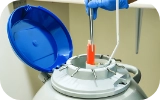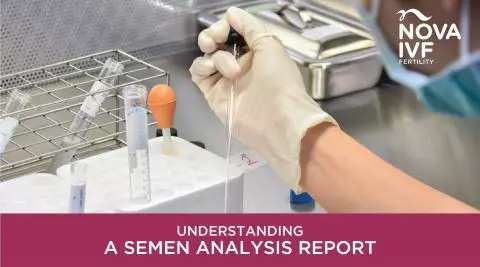Hysterosalpingography Test

If you are planning to have a baby, it's essential to know that there are many parts of your body that need to function well in order to conceive. Your uterus should be healthy, your ovaries must produce eggs regularly every month, and your fallopian tubes need to be open and unblocked.
Even if any one of these parts is not working appropriately, then you will have trouble getting pregnant. In order to evaluate the exact cause of infertility, doctors may recommend a test called hysterosalpingography (HSG). This article explores the purpose of the hysterosalpingography procedure and everything you need to know about this test.
What Is HSG Test?
Hysterosalpingography test, usually referred to as HSG, is an X-ray test performed to examine blockage in the fallopian tubes and uterus; uterus is the womb of the women and fallopian tubes are tube-like structures attached to the uterus that serve the purpose of catching a mature egg released from the ovaries during ovulation and transport it to the uterus. Uterosalpingography is another name for the hysterosalpingography test.
This test is also used to check whether the uterus is in good condition and free of any fibroids, polyps, or scar tissues. This test usually lasts for about 30 minutes or less. If there is partial or full blockage in the fallopian tubes, it will show up on an HSG. It can also show size and shape of the uterus.
When Is a Hysterosalpingography Test Performed?
HSG is usually recommended to investigate the cause of infertility and problems with pregnancy due to scarring or abnormalities in the fallopian tubes or the uterus. Your doctor may also recommend an HSG a few months after certain tubal sterilisation procedures to ensure the complete blockage of fallopian tubes.
Infertility can be caused by any of the following:
- Blockages in the fallopian tubes
- Scar tissue inside the uterus
- Uterine polyps or tumours
- Structural abnormalities in the reproductive system
- Uterine fibroids
Your doctor may also recommend an HSG test to observe your progress and monitor your health after a recent tubal surgery. For example, if you recently went for a tubal litigation, which is a process of closing the fallopian tubes as a birth control measure, your doctor will recommend an HSG to ensure that your fallopian tubes are closed properly. Doctors recommend an HSG for people who had their tubal litigation reversed as well to ensure their fallopian tubes are not closed anymore.
However, HSG test cannot be performed if you are pregnant, experience uterine bleeding during the process, or have a pelvic infection.
HSG procedure is usually performed in a hospital or clinic. The test is usually performed in the first half of your menstrual cycle, i.e. day 1 to 14.
Who Performs a Hysterosalpingography Test?
A radiologist, gynaecologist, or reproductive endocrinologist can perform an HSG for you. After the test is completed, a radiologist will assess your results and draft a report to share their finding with your healthcare provider.
The radiologist can watch the dye move inside your uterus and fallopian tubes and understand whether you have any blockages or not. They will be able to observe structural abnormalities in your reproductive system as well during a hysterosalpingography test.
How Should I Prepare for Hysterosalpingography procedure?
Your doctor may recommend you take an over-the-counter pain reliever and about an hour before the test. In some cases, the doctor may also suggest an antibiotic to prepare for the procedure. Most people are able to drive themselves to and from the test centre, but you can bring a loved one with you for moral support.
How is HSG Performed?
For this procedure, a thin catheter is inserted through the vagina into the uterus, and a contrast liquid dye is injected. The dye spreads taking the shape of the womb, making it possible to see the fallopian tubes clearly in the fluoroscopic X-ray. The dye should flow freely through the uterus if there is no blockage. If the dye stops spreading at any point, it may be a sign of tubal blockage.
A tubal blockage is the most common cause of infertility among women and if diagnosed, doctors suggest a surgical repair or opting directly for IVF.
Here is a step-by-step procedure of HSG:
- You start by changing into stirrups and lying on your back with your feet placed on the table and knees bent. Your body position for an HSG is similar to the position of your pelvic exam.
- A trained professional will insert a speculum into the vagina to provide easy access to the cervix.
- Cervix is cleaned and a small catheter is inserted in the cervical canal to reach the uterus. Local anaesthesia may also be used to relieve pain during the procedure.
- After removing the speculum, your provider will ask you to straighten your legs on the table.
- A contrast liquid dye is slowly inserted into the uterus while a radiology technician operates the X-ray machine. The fluid may cause cramping.
If the fallopian tubes are blocked, it will show up in the X-ray. Slight stretching of the fallopian tubes indicate a blockage in the tube. If there is no blockage the fluid will spill from the far end of the fallopian tubes and absorbed by your body without any consequences later on.
- X-ray images are then during the procedure taken care to be examined by your healthcare provider later.
During the imaging process, the radiology technician may change your positions slightly to assess how the contrast material moves through your fallopian tubes.
- After taking the images, the healthcare professionals will remove the catheter from your body. The speculum is not required to remove the catheter.
What should you expect during a hysterosalpingography (HSG) Test?
An HSG test takes usually less than 5 minutes to perform. The preparation of the procedure may take a little longer. You can go home on the same day of the procedure. A healthcare professional will injection contrast material into your uterus and check the size and shape of the uterus along with examining the fallopian tubes for any blockages. X-ray images of an HSG test are recorded during the procedure to be later examined by your care provider.
Is HSG procedure painful?
It is common to experience mild pain or discomfort during and after an HSG test. Some people experience cramping when the contrast dye is inserted into their uterus. People who have blockage in their fallopian tubes may experience more cramping than people who don’t have any blockages in their fallopian tubes.
The cramping caused by HSG may last only for about 5 minutes after the procedure or extend up to a few hours after the test. Different people may experience different levels of pain or discomfort. Your healthcare provider may suggest some over-the-counter pain reliever to alleviate your cramps.
Risks and side effects after hysterosalpingography procedure
Although there are usually no risks of getting an HSG, some people may get an allergic reaction to the contrast dye used in the procedure. Injury to the uterus or pelvic infection is also a rare possibility of getting an HSG.
Since the amount of radiation used in an HSG test is minimal, getting this procedure done usually doesn’t involve any risk.
Results of Hysterosalpingography Test
The radiology technician can gauge whether you have a blockage in your fallopian tubes or not during the procedure itself. However, it is important for a radiology specialist to evaluate your test reports to prepare the final result with a detailed report. Thus, it may take up to a week or so to receive your HSG test results. After reviewing your test results, your care provider will discuss the findings with you and create a plan that aligns with your goals.
In case your HSG test results show blockage in the fallopian tubes, your care providers may laparoscopy or other procedures to investigate further and treat the problem. Fertility treatments, like in vitro fertilisation may also be recommended to people who have blockage in their fallopian tubes to facilitate conception.
When should you call a doctor?
Contact your doctor immediately if the side effects are drastic and you have any of the following symptoms:
- Heavy vaginal bleeding
- Fainting
- Fever or chills
- Severe pain or abdominal cramping
- Vomiting
- Foul-smelling discharge from the vagina
The above-mentioned complications are a rare phenomenon; thus, it is safe to go for the test.
Summing Up
Hysterosalpingography is a diagnostic test that is used to evaluate any potential blockages in the fallopian tubes and examine the shape and size of the uterus.
Since it is a diagnostic-only test, recovery is very quick after hysterosalpingography. You can resume your regular routine the very next day. HSG is generally safe and free of complications, but some women may experience a little bit of spotting and cramps after having an HSG test done. If you are experiencing any concerning symptoms after the hysterosalpingography test procedure, you are advised to consult your care provider immediately.
FAQS About Hysterosalpingography Test
Q. Is there an alternative to hysterosalpingography (HSG)?
A. Yes. Your doctor may recommend laparoscopy, hysteroscopy, sonohysterosalpingography, and sonohysterography in case you cannot have an HSG.
Q. Does a hysterosalpingography test increase my chances of getting pregnant?
A. No. Some studies suggest that injecting contrast material or dye into the uterus for the purpose of opening blockage in fallopian tubes may improve fertility, especially during the first few months after the procedure; this process is known as tubal flushing. However, there is more research required to confirm the benefits of tubal flushing for women with blockages in fallopian tubes who are trying to conceive naturally.
Q. Can HSG clear the blockages in my fallopian tubes if there are any?
A. The answer is both yes and no. The procedure of an HSG test may help clear minor blockages, but if there is significant blockage in the fallopian tubes, it may be of no help on its own.
Q. What if I get pregnant right after HSG is performed?
A. It is usually considered safe to engage in unprotected sexual intercourse a few days after the test procedure. You are advised to confirm with your care provider if you are unsure about trying to conceive.
 Infertility Counselling
Infertility Counselling Female Infertility Treatment
Female Infertility Treatment Andrology Treatment
Andrology Treatment Fertility Enhancing Surgeries - Female
Fertility Enhancing Surgeries - Female Fertility Enhancing Surgeries - Male
Fertility Enhancing Surgeries - Male Endoscopy Treatment
Endoscopy Treatment IUI Treatment
IUI Treatment IVF Treatment
IVF Treatment ICSI Treatment
ICSI Treatment Advanced IVF Solutions
Advanced IVF Solutions Embryology
Embryology Vitrification Egg, Embryo, Sperm Freezing
Vitrification Egg, Embryo, Sperm Freezing Preimplantation Genetic Testing (PGT)
Preimplantation Genetic Testing (PGT) Donation Program Embryo / Egg / Sperm
Donation Program Embryo / Egg / Sperm












